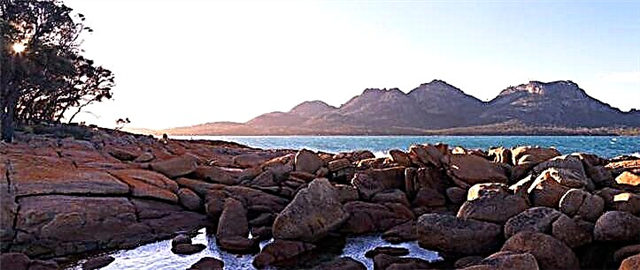Australia is a country located on a separate continent in the Southern Hemisphere. Geographically, the seasons here mirrored the seasons of the northern half of the Earth: summer is in December – February, and the coldest months are from June to August. Moreover, the mainland is located in several belts at once: subequatorial, tropical, subtropics. And on the island of Tasmania, which is an Australian state, the temperate zone begins. That is why it is impossible to talk about such a concept as a single climate in Australia: the weather here can be different depending on the region.

Climatic zones of the Australian continent
If you look at the map, you can see that the Southern Tropic of Capricorn, which defines the climatic zones of Australia, runs through the entire territory of the mainland approximately in the middle from east to west.
Basically, there are only two seasons here: rainy winters and dry, hot summers. The exception is the northern part of the country - the subequatorial region. The region is influenced by the South Tradewind Current, which brings precipitation in December-February and clear, sunny weather in winter. In the north, there are rainforests and savannahs, and deserts begin. In the middle of the continent, in the Tropic of Capricorn region, there are deserts.
Australia is considered an arid continent with 5 times less rainfall than Africa. Only on the coast of the Pacific Ocean, where there is more moisture, tropical forests grow.
To the south of the tropics there are subtropics with hot summers and rainy winters. The peculiarity of this climatic zone is the low amount of precipitation in the west, respectively, the vegetation is scarce or none at all.
But in the southeast, where there is enough moisture, the most favorable conditions for people have developed: full-flowing rivers, rich flora and fauna. The largest cities in Australia are located here.
The climate of Tasmania resembles the Central European one: warm summers and rather cool winters.
Take a sociological survey!
Winter in Australia
Traditionally, it is believed that Australia is a warm country: even in winter, the temperature at night on the mainland does not drop below + 5 ° C. At the same time, the lack of central heating and poor thermal insulation of houses lead to the fact that in large cities in the southeast, many feel uncomfortable in June-August.
And only in the northern, subequatorial part of the country eternal summer reigns: up to + 30 ° C.
The Australian winter attracts tourists with recreation in the Great Barrier Reef area, as well as observing wild animals: kangaroos, wallabies, koalas. The underwater world of corals and tropical fish is stunningly beautiful, which divers can admire.
 In winter, Australia's rainy season begins in densely populated regions. At the same time, in Melbourne and Sydney in July, the thermometer often drops to + 10 ... + 12 ° C, at night only + 5 ° C. The wet, cool weather is reminiscent of the European winter. In the southern regions, there may be night frosts, but stable snow lies only in the mountains - the Australian Alps.
In winter, Australia's rainy season begins in densely populated regions. At the same time, in Melbourne and Sydney in July, the thermometer often drops to + 10 ... + 12 ° C, at night only + 5 ° C. The wet, cool weather is reminiscent of the European winter. In the southern regions, there may be night frosts, but stable snow lies only in the mountains - the Australian Alps.
In the central regions, it is warmer: up to + 20 ° C, but in the Great Victoria Desert, the temperature is twice lower. In Perth, on the shores of the Indian Ocean, the air is cooled to + 18 ° C, and at night - to + 6 ° C.
Weather in Australia by months in winter is presented in the table:
| December | January | February | |
|---|---|---|---|
| Sydney | 17-26 | 19-26 | 19-26 |
| Melbourne | 12-24 | 17-26 | 17-27 |
| Canberra | 11-26 | 13-28 | 13-28 |
| Perth | 15-29 | 17-32 | 17-32 |
| Adelaide | 14-26 | 17-28 | 17-28 |
| Darwin | 25-33 | 25-32 | 25-31 |
Spring in Australia
Spring comes from September to November. In most regions, the weather is warm and comfortable: not very hot, but not cold either.
When on the territory of Europe, Russia, North America the day is rapidly decreasing and cold comes, on the Australian continent everything blooms, rare plants smell, and vacationers sunbathe and swim on numerous beaches.
 In October, in most of the country, the air warms up to + 20 ... + 23 ° C, and in November, real summer weather sets in: up to + 25 ° C, on the tropical coast - up to + 33 ° C. If you have not yet decided when to go to Australia, you can choose this bright warm season for your vacation.
In October, in most of the country, the air warms up to + 20 ... + 23 ° C, and in November, real summer weather sets in: up to + 25 ° C, on the tropical coast - up to + 33 ° C. If you have not yet decided when to go to Australia, you can choose this bright warm season for your vacation.
The main event of the Australian spring is the Melbourne Cup races, which, by tradition, are closely watched by the whole country and numerous tourists.
Characteristics of weather conditions by months:
| December | January | February | |
|---|---|---|---|
| Sydney | 17-26 | 19-26 | 19-26 |
| Melbourne | 12-24 | 17-26 | 17-27 |
| Canberra | 11-26 | 13-28 | 13-28 |
| Perth | 15-29 | 17-32 | 17-32 |
| Adelaide | 14-26 | 17-28 | 17-28 |
| Darwin | 25-33 | 25-32 | 25-31 |
Summer in Australia
In December, the hot season begins, the mainland is very hot. The climatic conditions in Australia at this time are favorable for a beach holiday.
- In the central regions in the desert there is a heat up to + 36 ... + 40 ° C, there is no rain - drought.
- In the north (in Darwin), the air temperature reaches + 30 ° C, water - + 28 ° C.
- In Perth, in the west, it is also hot: up to + 30 ° C.
- In the southeast, the Mediterranean weather: in Melbourne in January - + 25 ... + 27 ° C, and the water in the ocean is rarely warmer than + 19 ... + 22 ° C.

- In Tasmania, an almost British climate dominates: during the day it is comfortable + 20 ... + 22 ° C, at night + 10 ... + 12 ° C.
- In January-February, in the north of the country, air and water stop at around + 30 ° C, and almost daily in the northern region there are heavy tropical showers, often flooding the roads.
- In the south and east, the air temperature is up to + 27 ° C, there is little precipitation.
Here's what the temperature readings look like in major cities of the country:
| December | January | February | |
|---|---|---|---|
| Sydney | 17-26 | 19-26 | 19-26 |
| Melbourne | 12-24 | 17-26 | 17-27 |
| Canberra | 11-26 | 13-28 | 13-28 |
| Perth | 15-29 | 17-32 | 17-32 |
| Adelaide | 14-26 | 17-28 | 17-28 |
| Darwin | 25-33 | 25-32 | 25-31 |
Autumn in Australia
The beautiful autumn season lasts from March to May. Parks, reserves, forests burn with flowers of yellow, bronze, red foliage. Many come to see this fascinating sight.
Traditionally, festivals of farmers, culinary specialists and winemakers are held in autumn, attracting crowds of tourists from different countries.
 Summer weather is still everywhere in March. The climate of South Australia pleases with temperatures of + 23 ... + 27 ° C, there is little rain - 45-70 mm.
Summer weather is still everywhere in March. The climate of South Australia pleases with temperatures of + 23 ... + 27 ° C, there is little rain - 45-70 mm.
In tropical regions, the heat continues to + 32 ° C, here at this time there are still heavy rains. The ocean water temperature ranges from + 21 ° C in the south to + 30 ° C in the north. But already in May it gets cooler: in most of the territory, the air temperature is about + 20 ° C.
| December | January | February | |
|---|---|---|---|
| Sydney | 17-26 | 19-26 | 19-26 |
| Melbourne | 12-24 | 17-26 | 17-27 |
| Canberra | 11-26 | 13-28 | 13-28 |
| Perth | 15-29 | 17-32 | 17-32 |
| Adelaide | 14-26 | 17-28 | 17-28 |
| Darwin | 25-33 | 25-32 | 25-31 |
Best time to visit Australia
Since the climate in Australia is diverse, you need to clearly figure out where and when it is best to go. According to statistics, most tourists prefer to spend December-January here in order to enjoy the warmth during the cold season in their native lands. By May, this stream has practically dried up, although in Australia you can find entertainment at any time of the year.
At first glance, the temperature in the north of the country around Darwin and the Great Barrier Reef is favorable for swimming all year round, but it rains heavily from December to March. Cyclones often destroy infrastructure and are life-threatening. The best period for a tropical beach holiday is from May to October.
In the east and southeast - in Sydney, Melbourne, Canberra - the weather is suitable for recreation all year round, but in Sydney there are frequent showers from January to June, and it is cool in June-August. Therefore, it is better to postpone your visit here until September-December.
In the west, in the Perth region, summers are hot and dry, it is good to relax here from October to May. In June, the rainy season begins and the rest becomes uncomfortable.
It is extremely rare for tourists to go to the central deserted part of the mainland - it is hot, dry, and only extreme lovers will be interested in staying.
In Tasmania, the sea is almost always cool, it often rains, and it is cold in winter, gusty Antarctic winds blow.
What things to take with you on a trip
 You already understood what the climate is in Australia, therefore, when going on a trip, focus on the specific season and region where you are going.If your holiday is planned for Christmas and New Years, keep in mind that Australia has a hot summer during this period, so only light clothing will be required. Be sure to take a swimsuit, swimming trunks, a hat or cap, glasses that protect from the sun.
You already understood what the climate is in Australia, therefore, when going on a trip, focus on the specific season and region where you are going.If your holiday is planned for Christmas and New Years, keep in mind that Australia has a hot summer during this period, so only light clothing will be required. Be sure to take a swimsuit, swimming trunks, a hat or cap, glasses that protect from the sun.
If you are going to walk a lot and visit different regions of the country, take a light windbreaker, comfortable shoes. A waterproof raincoat, an umbrella will not interfere.
In winter, in the mountains of Australia, you can go skiing, snowboarding - take with you equipment and warmer clothes.
If you are planning to fly to Sydney, Canberra, Melbourne in winter (June – August), take a warm jacket and waterproof shoes, sweaters, trousers - they will be useful to you.
Keep in mind that you can bring personal belongings to Australia for no more than 90,000 Australian dollars (about 4 million rubles). This includes the cost of a smartphone, laptop, jewelry on you, branded models, so do not take very expensive items.
Do not forget to put a Type I adapter plug in your suitcase, since the sockets are different from the Russian ones. But if you feel the need for some missing things, you can always go to the stores.
The article “Shopping tour to Australia: what to bring for yourself, family and friends” tells in detail what and where to buy.
Facts that interest you
Desert and semi-desert areas may not rain for several years. Over the past 200 years, there have been many very severe droughts. Drought over most of the country in 1963-1968 caused a 40% drop in the wheat crop, and in central Australia this phenomenon lasted even longer: from 1958 to 1967.
The mountain range along New South Wales and the Victoria Desert is an area where it snows a lot in winter. Ski resorts are located here. The season in the Australian Alps runs from June to September.
 Tropical cyclones threaten most of the northern part of the country between November and April. They bring big trouble to the inhabitants of this territory. So, the famous cyclone Tracy in 1974 hit Darwin on Christmas Day: as a result, 49 people died, 600 were injured, and the city was destroyed by 80%.
Tropical cyclones threaten most of the northern part of the country between November and April. They bring big trouble to the inhabitants of this territory. So, the famous cyclone Tracy in 1974 hit Darwin on Christmas Day: as a result, 49 people died, 600 were injured, and the city was destroyed by 80%.
The desert in the interior of the mainland is characterized by high temperatures during the day and cold nights. In summer, the air warms up to + 40 ° C, in winter - up to + 24 ° C. But nighttime temperatures can drop to zero.
Conclusion
Australia remains a mysterious and amazing country for many inhabitants of the Northern Hemisphere. No wonder it attracts tourists from all over the world.
When going on vacation or visiting, find out which part of Australia you will live in and plan your trip accordingly, taking into account the climatic features of the region.












